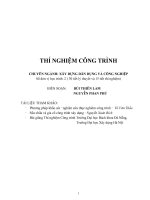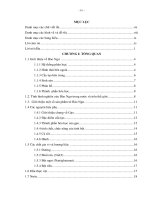Nghiên cứu DRACAENA ANGUSTIFOLIA
Bạn đang xem bản rút gọn của tài liệu. Xem và tải ngay bản đầy đủ của tài liệu tại đây (123.01 KB, 3 trang )
129
Journal of Chemistry, Vol. 42 (1), P. 129 - 131, 2004
STUDY OF DRACAENA
ANGUSTIFOLIA
I - NEW SPIROSTANOL SAPOGENINS FROM ROOTS AND RHIZOMES
Received 14-5-2003
TRAN LE QUAN
1
, TRAN KIM QUI
1
, SHIGETOSHI KADOTA
2
1
College of Natural Sciences, National University Ho Chi Minh City, Ho Chi Minh City
2
Institute of Natural Medicine, Toyama Medical & Pharmaceutical University, Toyama, Japan
SUMMARY
The MeOH extract of Nam ginseng (roots and rhizomes of Dracaena angustifolia)
afforded three new spirostanol sapogenins, named namogenins A-C (1-3). Their structures
were determined on basis of spectral analyses and chemical methods.
1. INTRODUCTION
Dracaena angustifolia Roxb. (Dracaenaceae)
is locally known as Nam ginseng (ginseng from
the South) in Quang Nam province. Its
underground parts are used as tonic and for
treatment of leukemia [1].
In our continuing studies on Vietnamese
medicinal plants, we have examined the
constituents of Nam ginseng (D. angustifolia)
and isolated three new spirostanol sapogenins.
This paper reports the isolation and structure
elucidation of these new compounds.
2. RESULTS AND DISCUSSION
Air-dried roots and rhizomes of D. angusti-
folia were extracted successively by refluxing
MeOH, 50% aqueous MeOH and water to give
MeOH, MeOH-H
2
O and H
2
O extracts, respec-
tively. The MeOH extract was subjected to
Diaion HP-20 column chromatography (CC).
The MeOH eluate was further separated by a
combination of silica gel and ODS column
chromatographies, and normal- and reversed-
phase pTLC, to afford three new compounds,
named namogenins A-C (1-3).
O
HO
HO
O
OH
OH
3
O
HO
HO
O
R
OH
25
1
2
R = OH, 25R,S
R = H, 25S
H
H
H H
1
3
6
9
11
13
14
16
17
20
22
23
24
26
27
18
19
21
Negative-ion HRFABMS of 1 displayed a
quasi-molecular ion at m/z 461.2859, indicating
the molecular formula C
27
H
42
O
6
. The
1
H NMR
spectrum of 1 showed signals ascribable to two
tertiary methyls and three secondary methyls,
while the
13
C NMR spectrum of 1 showed
1 R = OH, 25R,S 3
2 R = H, 25S
130
twenty seven signals (Table 1). Analysis of the
COSY and HMQC spectra, together with the
molecular formula, suggested 1 to be a
spirostane-type steroid, but the
1
H and
13
C NMR
signals ascribable to ring F appeared as pairs of
signals, indicating that 1 was a C-25 epimeric
mixture. Since its isolation was very difficult, as
reported for similar epimeric mixtures [2], and
could not be done, the structure of 1 was
elucidated by spectroscopic analysis of the
epimeric mixture.
Table 1:
13
C NMR data () for compounds 1 -3
in pyridine-d
5
1 2 3
1 78.2 78.2 78.2
2 43.6 43.6 43.7
3 68.1 68.1 69.1
4 44.0 44.0 44.1
5 139.8 139.8 139.8
6 124.9 125.0 124.9
7 26.4 26.9 26.4
8 37.5 36.8 37.5
9 44.4 44.5 44.4
10 43.9 43.9 43.9
11 23.2 23.6 23.2
12 27.2 32.7 27.2
13 48.1 44.8 48.2
14 88.2 86.8 88.3
15 40.6 40.1 40.6
16 90.5 81.9 90.8
17 91.2 59.9 91.2
18 21.0 20.4 21.0
19 14.0 13.9 14.0
20
45.2
a
45.7
b
42.5 45.1
21
9.9
a
9.5
b
15.2 9.9
22
109.6
a
110.0
b
110.0 109.8
23
32.2
a
26.7
b
26.5 33.6
24
28.9
a
25.8
b
26.3 28.7
25
30.4
a
27.4
b
27.6 144.2
26
66.8
a
65.0
b
65.0 64.9
27
17.3
a
16.3
b
16.3 108.8
a,b
Data for the 25R- and 25S-epimers,
respectively.
Analysis of the COSY and HMQC spectra
indicated the disappearance of the methine
carbons assignable to C-14 and C-17, but instead
of them,
13
C NMR spectrum showed signals of
two quaternary carbons at 88.2 and 91.2. Thus,
C-14 and C-17 seemed to have hydroxyl groups,
which were confirmed by the HMBC correla-
tions of H
3
-21 and H-16 with the quaternary
carbon at 91.2 (C-17) and of H
3
-18 with both
quaternary carbons at 91.2 (C-17) and 88.2 (C-
14). The -orientation of 14-OH and 17-OH was
deduced by a comparison of the
13
C NMR data
with that of (25R)-spirost-5-en-3,14,17-triol
(ophiogenin) [3]. Thus, 1 was determined to be a
mixture (1 : 1) of (25R)- and (25S)-spirost-5-en-
1,3,14,17-tetrol, which were named as
(25R)- and (25S)-namogenin A, respectively.
Negative-ion HRFABMS of 2 indicated the
molecular formula C
27
H
42
O
5
, one oxygen atom
less than 1. The
1
H and
13
C NMR spectra of 2
were similar to those of 1, indicating 2 also to be
a spirostane-type steroid. However, the signals
ascribable to ring F protons and carbons
appeared as only one set, and the chemical shifts
of H
3
-27 ( 1.06) and of C-23 to C-27 (Table 1)
suggested 2 to be a 25S-spirostane-type steroid
[4, 5]. The
13
C NMR spectrum of 2 revealed a
highfield shift ( 59.9) of the oxygenated quater-
nary carbon assigned to C-17 in 1. Thus, C-17
was considered to be a methine group, which
was confirmed by the
1
H-
1
H connectivity
deduced by the analysis of the COSY and
HMQC spectra and the HMBC correlations of
the methine carbon at 59.9 (C-17) with H
3
-21
( 1.17), H
3
-18 ( 1.18) and H-16 ( 5.10) and of
the quaternary carbon at 86.8 (C-14) with H
3
-
18 ( 1.18). Thus, namogenin B was determined
to be (25S)-spirost-5-en-1,3,14-triol (2).
The molecular formula of namogenin C (3)
was determined by negative-ion HRFABMS to
be C
27
H
40
O
6
, two hydrogen atoms less than 1.
The
1
H and
13
C NMR spectra of 3 were almost
the same as those of 1 (Table 1), except for the
appearance of signals for an exo-olefin (
H
4.79,
2H;
C
144.2, 108.8) and the disappearance of
the signals of a secondary methyl (CH
3
-27) and
a methine (CH-25). Thus, 3 was considered to be
131
a 25,27-dehydro derivative of 1, which was
supported by the HMBC correlations of the
exo-olefinic protons ( 4.79, H
2
-27) with C-24
( 28.7) and C-26 ( 64.9). Thus, namogenin C
was determined to be spirosta-5,25(27)-dien-
1,3,14,17-tetrol (3).
3. EXPERIMENTAL SECTION
General experimental procedures. Optical
rotations were measured on a JASCO DIP-140
digital polarimeter at 25°C. NMR spectra were
recorded on a JEOL JNM-LA400 spectrometer
in pyridine-d
5
, using TMS as an internal
reference. FABMS and HRFABMS was
performed using a JEOL JMS-700T mass
spectrometer and glycerol was used as matrix.
Plant material. Nam ginseng (roots and
rhizomes of D. angustifolia) were collected in
Quang Nam province, Vietnam, in November
1998.
Extraction and isolation. Air-dried roots
and rhizomes of D. angustifolia (440 g) were
extracted by refluxing with MeOH, MeOH-H
2
O
and H
2
O successively to give MeOH (78 g),
MeOH-H
2
O (77 g) and H
2
O (5.5 g) extracts,
respectively. Part of the MeOH extract (70 g)
was subjected to Diaion HP-20 CC and eluted
with H
2
O and then MeOH to give a MeOH
fraction (7.2 g). The MeOH fraction was then
chromatographed on silica gel with CHCl
3
-
MeOH-H
2
O (14 : 6 : 1) to give 7 fractions. Fraction
1 (1.5 g) was again chromatographed on silica gel
to give 3 subfractions. Subfraction 2 (520 mg)
was separated on normal- (CHCl
3
-MeOH-H
2
O,
14 : 6 : 0.5) and reversed-phase (MeOH-MeCN-
H
2
O, 2 : 2 : 1) pTLC to afford 1 (10 mg), 2 (11.6
mg), 3 (1.6 mg).
A mixture (1 : 1) of (25R)- and (25S)-Namo-
genin A (1): colorless amorphous solid;
25
D
][
-
69.2° (c 0.6, MeOH);
1
H NMR (C
5
D
5
N) 5.70
(1H, d, J = 5.4 Hz, H-6), 4.78 (1H, m, H-16), 4.03
(1H, dd, J = 10.1, 2.7 Hz, H-26 of 25S-isomer),
3.93 (1H, m, H-3), 3.85 (1H, dd, J = 11.7, 4.2 Hz,
H-1), 3.49 (2H, m, H
2
-26 of 25R-isomer), 3.28
(1H, br d, J = 10.1 Hz, H-26 of 25S-isomer), 2.23
(3H, d, J = 7.1 Hz, H
3
-21), 1.42 (3H, s, H
3
-19),
1.20 (3H, s, H
3
-18), 1.06 (3H, d, J = 7.1 Hz, H
3
-
27 of 25S-isomer), 0.68 (3H, d, J = 5.4 Hz, H
3
-
27 of 25R-isomer);
1
3
C NMR, see Table 1;
FABMS m/z 461.3 [M-H]
–
; HRFABMS m/z
461.2859 (calcd for [M-H]
–
461.2904).
Namogenin B (2): colorless amorphous solid;
25
D
][
-74.5° (c 0.8, MeOH);
1
H NMR (C
5
D
5
N)
5.71 (1H, d, J = 5.5 Hz, H-6), 5.10 (1H, m, H-
16), 4.05 (1H, dd, J = 10.8, 2.6 Hz, H-26), 3.33
(1H, br d, J = 10.8 Hz, H-26), 3.92 (1H, m, H-
3), 3.84 (1H, dd, J = 11.5, 4.0 Hz, H-1), 2.82
(1H, m, H-17), 1.43 (3H, s, H
3
-19), 1.18 (3H, s,
H
3
-18), 1.17 (3H, d, J = 7.2 Hz, H
3
-21), 1.06
(3H, d, J = 7.0 Hz, H
3
-27);
1
3
C NMR, see Table
1; FABMS m/z 445.3 [M-H]
–
; HRFABMS m/z
445.2956 (calcd for [M-H]
–
445.2954).
Namogenin C (3): colorless amorphous solid;
25
D
][
-29.8° (c 0.6, MeOH);
1
H NMR (C
5
D
5
N)
5.72 (1H, d, J = 5.1 Hz, H-6), 4.83 (1H, t, J =
6.4 Hz, H-16), 4.79 (2H, br s, H
2
-27), 4.46 (1H,
d, J = 11.9, H-26), 3.97 (1H, d, J = 11.9, H-26),
3.93 (1H, m, H-3), 3.88 (1H, dd, J = 11.7, 4.1
Hz, H-1), 2.43 (1H, q, J = 7.3 Hz, H-20), 2.34
(1H, dt, J = 11.9, 4.6 Hz, H-9), 2.17 (1H, dt, J =
11.5, 4.6 Hz, H-8), 1.44 (3H, s, H
3
-19), 1.21
(3H, s, H
3
-18), 1.20 (3H, d, J = 7.3 Hz, H
3
-21);
13
C NMR, see Table 1; FABMS m/z 459.3 [M-
H]
–
; HRFABMS m/z 459.2751 (calcd for [M-H]
–
459.2746).
REFERENCES
1. V. C. Vo. Dictionary of Vietnamese Medicinal
Plants. Medicine Publisher, Ho Chi Minh
City, P. 128 (1996).
2. M. Miyakoshi, Y. Tamua, H. Masuda, K.
Mizutani, O. Tanaka, T. Ikeda. J. Nat. Prod.,
Vol. 63, P. 332 - 338 (2000).
3. H. Nakanishi, N. Kaneda. Yakugaku Zasshi,
Vol. 197, P. 780 - 784 (1987).
4. G.-A. Hoyer, W. Sucrow, D. Winkler.
Phytochemistry, Vol. 14, P. 539 - 542 (1975).
5. J. A. Jafer, T. A. Crabb, C. H. Turner, G.
Blunden. Org. Magn. Reson., Vol. 21, P. 576
- 579 (1983).









